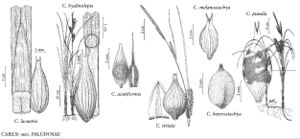Difference between revisions of "Carex heterostachya"
Enum. Pl. China Bor., 69. 1833.
imported>Volume Importer |
imported>Volume Importer |
||
| Line 59: | Line 59: | ||
|publication year=1833 | |publication year=1833 | ||
|special status=Introduced;Illustrated | |special status=Introduced;Illustrated | ||
| − | |source xml=https:// | + | |source xml=https://bitbucket.org/aafc-mbb/fna-data-curation/src/2e0870ddd59836b60bcf96646a41e87ea5a5943a/coarse_grained_fna_xml/V23/V23_917.xml |
|genus=Carex | |genus=Carex | ||
|section=Carex sect. Paludosae | |section=Carex sect. Paludosae | ||
Latest revision as of 21:44, 5 November 2020
Plants colonial; rhizomes long-creeping. Culms central, slender, trigonous, 25–60 cm, papillose and scabrous-angled distally. Leaves: basal sheaths brown, bladeless, rapidly disintegrating into fibers; ligules 0.7–1.5 mm, wider than long; blades somewhat glaucous, M-shaped, 1.5–3.2 mm wide, papillose abaxially. Inflorescences 2.5–12 cm; rachis beyond proximal pistillate spikes sharp-angled, often finely scabrous; proximal (1–)2–3(–4) spikes pistillate, not or barely overlapping, ascending; distal spikes erect; terminal 1 spike staminate. Pistillate scales ovate to broadly ovate, apex acute to acuminate-awned, awn to 1.3 mm, glabrous. Perigynia ascending, essentially veinless except for 2 marginal veins, ovoid, 3.1–4.5 × 1.7–2.5 mm, glabrous; beak 0.4–0.8 mm, bidentulate, teeth straight, 0.2–0.3 mm.
Phenology: Fruiting Jun–Jul.
Habitat: Dry, open or lightly shaded areas
Elevation: 200 m
Distribution

Introduced; Ill., e Asia.
Discussion
Carex heterostachya is a rare introduction from eastern Asia; first discovered in 1949, it is still extant and slowly spreading at its only known North American location (A. A. Reznicek 1994).
Selected References
None.
